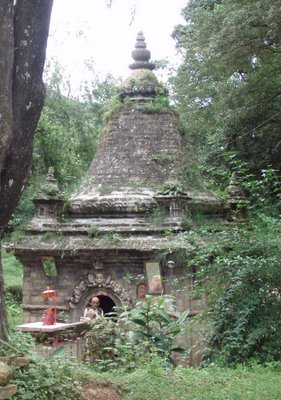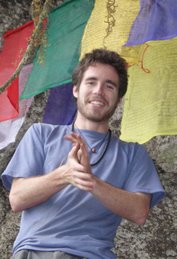also, if people want to send me packages or mail, this can be done like so:
michael smith
fulbright commission
po box 380
gyaneshwar, kathmandu, nepal
my other status symbols, an official visa and a motorcycle, are on the way. Motorcycles lessons are fun, but a little frustrating, as the bike is so heavy and i'm such a weakling.
tomorrow i will be going back across town with a few friends to restart a course in Tibetan grammar, taught according to indigenous Tibetan grammatical theory. I'm quite excited because we only got through subtleties of pronunciation with our teacher the translator Tony Duff last week. Hopefully with about a month of daily class my ability to read and translate will greatly improve.
 here is a photo taken of kantipath, one of the biggest roads in kathmandu, from a pedestrian bridge that crosses the road. as you can see, the nayanepal (new nepal) is on that faces many of the same problems as any rapidly expanding urban center. kathmandu is in a valley, so, like mexico city, the air pollution gets trapped, so it can get quite bad. the white and green three-wheelers are actually electric public vehicles that hold about ten people at a time and drive regular routes through the city. i use these "tempos," that are hand-me-downs from Thailand, quite a lot.
here is a photo taken of kantipath, one of the biggest roads in kathmandu, from a pedestrian bridge that crosses the road. as you can see, the nayanepal (new nepal) is on that faces many of the same problems as any rapidly expanding urban center. kathmandu is in a valley, so, like mexico city, the air pollution gets trapped, so it can get quite bad. the white and green three-wheelers are actually electric public vehicles that hold about ten people at a time and drive regular routes through the city. i use these "tempos," that are hand-me-downs from Thailand, quite a lot. this is the saraswati mandir (temple) located at the end of Lelegaon, about a half an hour up from Chapagaon on the road away from Kathmandu. Saraswati is the goddess of learning and music, depicted with a book and a lina, an ancient Indian prototype of the sitar.
this is the saraswati mandir (temple) located at the end of Lelegaon, about a half an hour up from Chapagaon on the road away from Kathmandu. Saraswati is the goddess of learning and music, depicted with a book and a lina, an ancient Indian prototype of the sitar. a closeup of the mandir, you can see a Newari Hindu priest at the door there. the temple itself is dedicated to shiva, i think, and the saraswati shrine is actually under the roots of a peripheral tree, with a natural pool below. for a few rupees the priest gladly gave a blessing to me and anyone else who happened to be around and willing. many temples in nepal are overgrown with plants, set amongst an amazing natural scene. this one is quite old, as are many other temples in the kathmandu valley, and has likely been in regular use for possibly up to a millineum. the mirror on the right side of the door is practically for checking the tika blessing you will recieve (the little dot at the spot of the third eye); symbolically it is for the devotee to make obeisance to the divine nature within themselves.
a closeup of the mandir, you can see a Newari Hindu priest at the door there. the temple itself is dedicated to shiva, i think, and the saraswati shrine is actually under the roots of a peripheral tree, with a natural pool below. for a few rupees the priest gladly gave a blessing to me and anyone else who happened to be around and willing. many temples in nepal are overgrown with plants, set amongst an amazing natural scene. this one is quite old, as are many other temples in the kathmandu valley, and has likely been in regular use for possibly up to a millineum. the mirror on the right side of the door is practically for checking the tika blessing you will recieve (the little dot at the spot of the third eye); symbolically it is for the devotee to make obeisance to the divine nature within themselves. in boudha, the tamang and tibetan cultural neighborhood i've been staying in on and off the last few years, the head of the Sakya school of Tibetan buddhism, Sakya Kuma Rinpoche, conducted a few empowerments. at this long life empowerment, in which he transmitted the blessings of Amitayus (Tsepagme, the long life Buddha) to thousands of local Nepalis and Tibetans, it was quite hot during the midday, so many people brought umbrellas to shade themselves from the sun. It made for a colorful sea of fabric stretching out from the monastery, where Rinpoche is sitting on a throne in the front center.
in boudha, the tamang and tibetan cultural neighborhood i've been staying in on and off the last few years, the head of the Sakya school of Tibetan buddhism, Sakya Kuma Rinpoche, conducted a few empowerments. at this long life empowerment, in which he transmitted the blessings of Amitayus (Tsepagme, the long life Buddha) to thousands of local Nepalis and Tibetans, it was quite hot during the midday, so many people brought umbrellas to shade themselves from the sun. It made for a colorful sea of fabric stretching out from the monastery, where Rinpoche is sitting on a throne in the front center.


No comments:
Post a Comment